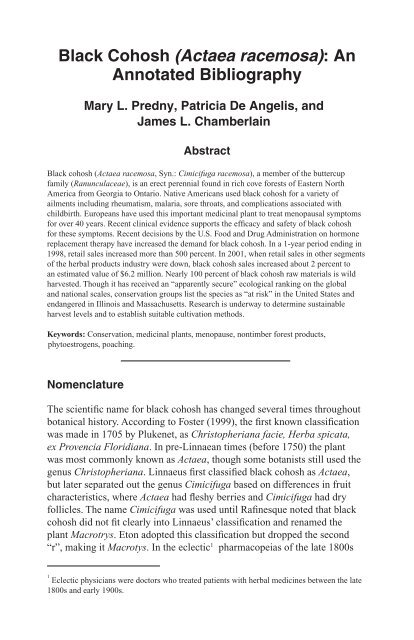Black Cohosh - Non-Timber Forest Products
Black Cohosh - Non-Timber Forest Products
Black Cohosh - Non-Timber Forest Products
You also want an ePaper? Increase the reach of your titles
YUMPU automatically turns print PDFs into web optimized ePapers that Google loves.
<strong>Black</strong> <strong>Cohosh</strong> (Actaea racemosa): An<br />
Annotated Bibliography<br />
Mary L. Predny, Patricia De Angelis, and<br />
James L. Chamberlain<br />
Abstract<br />
<strong>Black</strong> cohosh (Actaea racemosa, Syn.: Cimicifuga racemosa), a member of the buttercup<br />
family (Ranunculaceae), is an erect perennial found in rich cove forests of Eastern North<br />
America from Georgia to Ontario. Native Americans used black cohosh for a variety of<br />
ailments including rheumatism, malaria, sore throats, and complications associated with<br />
childbirth. Europeans have used this important medicinal plant to treat menopausal symptoms<br />
for over 40 years. Recent clinical evidence supports the efficacy and safety of black cohosh<br />
for these symptoms. Recent decisions by the U.S. Food and Drug Administration on hormone<br />
replacement therapy have increased the demand for black cohosh. In a 1-year period ending in<br />
1998, retail sales increased more than 500 percent. In 2001, when retail sales in other segments<br />
of the herbal products industry were down, black cohosh sales increased about 2 percent to<br />
an estimated value of $6.2 million. Nearly 100 percent of black cohosh raw materials is wild<br />
harvested. Though it has received an “apparently secure” ecological ranking on the global<br />
and national scales, conservation groups list the species as “at risk” in the United States and<br />
endangered in Illinois and Massachusetts. Research is underway to determine sustainable<br />
harvest levels and to establish suitable cultivation methods.<br />
Keywords: Conservation, medicinal plants, menopause, nontimber forest products,<br />
phytoestrogens, poaching.<br />
Nomenclature<br />
The scientific name for black cohosh has changed several times throughout<br />
botanical history. According to Foster (1999), the first known classification<br />
was made in 1705 by Plukenet, as Christopheriana facie, Herba spicata,<br />
ex Provencia Floridiana. In pre-Linnaean times (before 1750) the plant<br />
was most commonly known as Actaea, though some botanists still used the<br />
genus Christopheriana. Linnaeus first classified black cohosh as Actaea,<br />
but later separated out the genus Cimicifuga based on differences in fruit<br />
characteristics, where Actaea had fleshy berries and Cimicifuga had dry<br />
follicles. The name Cimicifuga was used until Rafinesque noted that black<br />
cohosh did not fit clearly into Linnaeus’ classification and renamed the<br />
plant Macrotrys. Eton adopted this classification but dropped the second<br />
“r”, making it Macrotys. In the eclectic 1 pharmacopeias of the late 1800s<br />
1<br />
Eclectic physicians were doctors who treated patients with herbal medicines between the late<br />
1800s and early 1900s.<br />
1


